The Guess Worker
Evolution
Overview:
-
Consciousness developed out of the nervous system
-
A crucial stage in its evolution was a decoupling of the reflexive arc
-
Consciousness evolved to improve responses
-
It motivates the search for favourable stimuli
History has all the answers. If we knew exactly what happened in the past we should be able to understand everything in the present. If we knew why consciousness evolved in animals long ago, we ought to be able to figure out how consciousness operates in the human brain today.
Unfortunately, though, we can't know for certain what happened in the past. But we can make some good guesses. The account below is the guess I subscribe to.
Origins
In the beginning, about 4 billion years ago in a part of the primordial earth's oceans, there was a prebiotic soup. This soup was a solution of organic molecules, some of which, such as amino acids, are still found in living organisms. The soup did not at first contain life. Life began by chance the moment certain chains of molecules started to replicate themselves.
The instant life began was also the instant natural selection began. Through replication the chains proliferated. But the chains weren't all identical: because of differences between them, some chains were more efficient at replicating than others. Some made more accurate copies, faster copies or more stable copies of themselves. Soon the most efficient replicators predominated in the soup.
The prevalence of one type was not the end of the story, though. Efficiency is only relative and any chain which became more efficient at replicating through a change in its structure became the new prevalent type.*1 It would take perhaps many million years before these chains starting producing ancillary molecules to assist with replication and then many million years more before the first lipid membranes enclosed these miniature biochemical factories in a protective environment. At that moment the first simple cells had evolved.
Internal communications
The first true multicellular organisms only appeared around 1.7 billion years ago. Before then cells had often grouped together for safety, but each cell in such colonies was independent and much like its neighbours. The difference between these clumps of cells and multicellular organisms was that cells in the latter had become diversified to fulfil different functions. Some cells, for example, may have become specialised for digestion, others to provide defence, and others to give movement.
For diversification to happen, cells need to know what to do. They need to receive and give instructions. Messages carrying these instructions have to pass between them.
Initially all messages between cells were chemical. Chemical messages, though, have some distinct disadvantages: they are slow and they do not hit their target well. Generally in organisms chemicals move by diffusion – a slow process, which means that a quick response to an urgent message sent from one end of an organism to another is impossible. Diffusion is also wasteful: much of the message ends up at cells which are not meant to respond and in turn, unless large amounts of the chemical are produced, the target cells might not even receive the message.*2
The answer was, of course, neurons. Nerve impulses in humans can travel at speeds of up to 120 metres per second which is thousands of times faster than molecules moving by diffusion. Nerve impulses are also perfectly accurate – they can be directed precisely and exclusively to the cells or tissues that are meant to receive the message.
Reflexes
The first kind of nervous response to stimuli was probably not much different in principle to those of the reflexive arc in humans. If we accidentally touch boiling water with our fingers, a reflex action makes us pull our hands away. The diagram below shows how neurons in the arc relay the message:
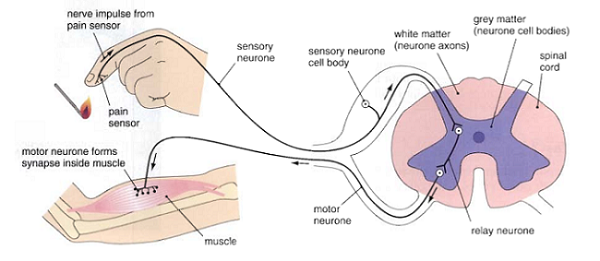 (Taken from http://danielscienceblogg.blogspot.com)
(Taken from http://danielscienceblogg.blogspot.com)
The reason the reflex is unconscious is that the nerve impulse only passes through the spinal cord – pain signals are only passed up to the brain later. Of course the first animals to develop a nervous system (which was without any kind of brain) would never have felt pain. All their actions would have been unconscious responses to stimuli, caused by similar reflexes to the one above.
The drawback of the reflex arc can best be illustrated by paring down the diagram above to its essentials:
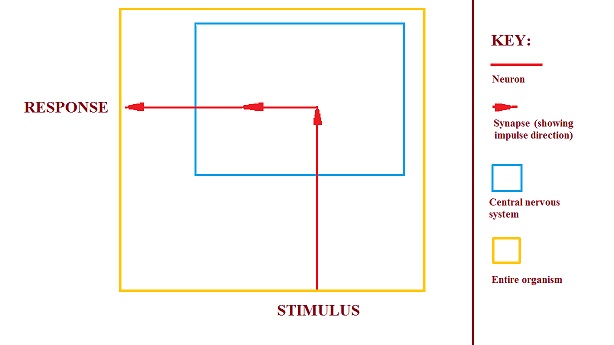
As long the stimulus activates the sensory neuron, the animal is bound to respond in the same way – which is probably why moths are always attracted to the light of lamps, even if it kills them. To avoid catastrophic situations like these some animals must have evolved a way of turning their responses off, let's say, whenever a stimulus became very strong. This could have happened by developing something like a fuse switch between the sensory and motor neurons:
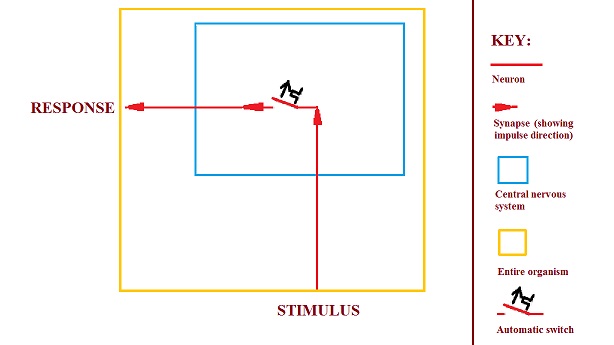
The switch would turn itself off when the signals from the stimulus became too frequent, so breaking the circuit and preventing a response. The switch would then turn back on again when the stimulus was no longer damaging.*3
Decoupling leads to pain
Of course, animals with this switch don't have to be conscious. But the evolution of the switch must have been a crucial step on the path towards consciousness. It allowed for a decoupling of set responses to specific stimuli. And this decoupling meant that signals from stimuli could be rerouted to produce sensations of pain:
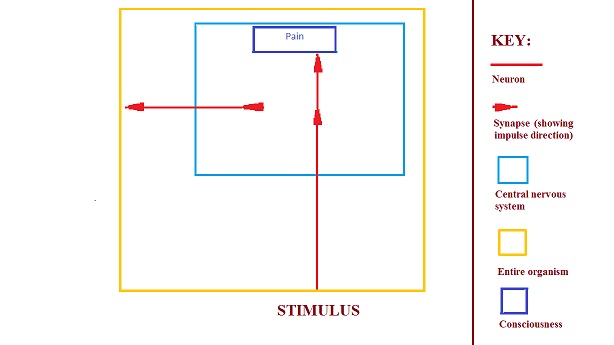
The first animals to experience pain were, of course, the first conscious animals. They were probably only aware of one thing – or, to put it another way, only one kind of stimulus caused them pain. What that stimulus was can't be known but it was likely to have been something that wasn't an immediate danger and yet which the animals had to avoid to survive – such as an empty stomach.
Reasons for hurting
It is clear that experiencing pain gave animals an advantage. What is less clear is what exactly that advantage was. It could be that pain simply makes an animal avoid harmful stimuli. Avoiding harmful stimuli, though, is something unconscious organisms do too, sometimes very well and very energetically.
It could be that consciousness made complex behaviour possible and so allowed for more versatile responses to danger. This doesn't seem too plausible: some apparently unconscious animals, such as ants and bees, show highly complex behaviour. *4 All that's needed for complex behaviour is complex wiring (that is, of neurons) plus good regulatory systems (such as the switch described above).
Finally, it could be that consciousness gave animals motivation.*5 This assertion, though, doesn't mean much without an explanation of what motivation is and what advantage it brings. Does it mean that animals which aren't conscious aren't motivated? If so, what makes them do what they need to do to survive and reproduce?
What is motivation?
In a sense all life is motivated. All organisms, conscious or not, are motivated by efficiency, just the first replicating molecules were. They are driven by competition towards reproducing in an increasingly effective way. Conscious animals, however, are motivated in a specific way – that is, through pain.*6. How, though, is being motivated by pain any more effective than being driven unconsciously, as ants and bees are?
The answer is that pain makes animals try hard. It makes them try hard to get rid of the pain. Animals will often exploit any possibility and exhaust all possibilities to stop pain. To do that they could use each of their motor responses in turn to see if any of them eliminate or reduce it. But that would be too long-winded and haphazard.
Instead, what conscious animals do is search for relevant information. Let's say you suddenly feel sharp pain at the back of your leg. You open your eyes wide, then you twist your head and your body to see what the problem is. You look to see if a cut or bite is visible and then you look to see what caused it. And usually you'll keep on looking until the mystery is solved.
Search and find
We could say, then, that pain motivates animals to keep on searching for relevant information until the pain ceases. In fact, being motivated to search for information means that they don't have to be motivated to do anything else. A look at the response of the first conscious animal to pain shows us why:
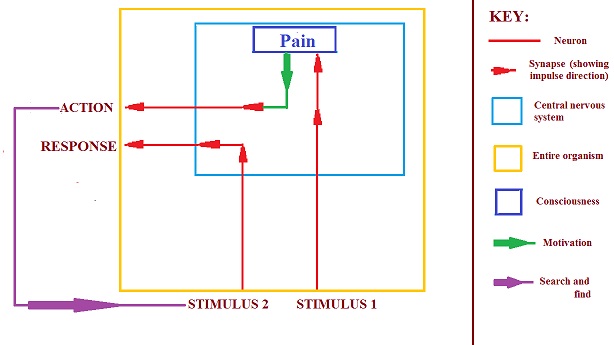
As mentioned before, this animal was only aware of one kind of stimulus – let's say an empty stomach. The pain of an empty stomach made it search for food, and it would keep on searching for food until it found some. Once food was spotted, though, reflex actions would make the animal move towards the food and eat it. In other words, the animal didn't have to be motivated to eat; it only had to be motivated to search.
Energy saving
The diagram also shows the advantage of conscious motivation over unconscious drives. An unconscious animal, even one with a regulatory switch, will not respond if there is no stimulus. In contrast, as long as a conscious animal feels pain, it will continue to search for stimuli. It could be said that unconscious animals are bound to wait passively until favourable stimuli come along, whereas conscious animals will actively go out and look for them.*7
How about ants and bees, though? They actively go out and look for food. Doesn't that blow a hole in the argument? I would say not. They are almost certainly prompted by stimuli such as daylight and temperature. As long as they have these stimuli, ants and bees forage for food continuously. Their behaviour works well for the niches they inhabit. But for some animals looking for food when it's not necessary would be a waste of precious energy. Consciousness gives them an extra advantage: they are not active when they don't feel pain.
The story doesn't end
Consciousness, then, is a motivator, which through pain makes animals seek favourable stimuli. It evolved out of animals' internal communication systems, which, like consciousness itself, evolved to improve responses. The arrival of consciousness, though, wasn't the end of that story. Next must have come awareness of more than one kind of stimulus. This in turn must have led to the capacity for decision making. Later consciousness's motivating power was exploited to develop other faculties of the mind such as memory and learning. How these faculties use consciousness will be the subject of future posts.
*1. Richard Dawkins is wrong: efficiency, not selfishness, is the motor of evolution. Worker ants don't labour for the colony because they are the future sisters of their queen's eggs. They labour for the colony because they are instruments of efficiency. They are no different in this respect to hormones, cell membranes, limbs or organs – or any feature of organisms which has evolved to improve the efficiency of DNA replication.
*2. These shortcomings were considerably reduced with the development of the circulatory system.
*3. Here is a possible mechanism for this switch. Suppose that a biochemical, which I'll call x, is released into the synapse in increasing amounts as the frequency of impulses increases. At high enough concentrations x stops the motor neuron from being fired. It could do this by binding to receptor sites normally occupied by the neurotransmitter. When there are few impulses, the neurotransmitter can bind to the receptors and the motor neuron fires normally. When the number of impulses per second are high, though, x floods the synapse and blocks the receptors. This prevents the neuron from being activated and the switch is turned off.
Suppose now that the signals from the stimulus become weaker and the number of impulses decreases. Less biochemical x is released in the synapse. Because of equilibrium forces, x will unbind from the receptors and will be replaced by the neurotransmitter. The motor neuron is activated again and the switch is turned on.
So for the switch to be turned off the concentration of x has to increase. And for the switch to be turned on again the concentration of x has to decrease. Possibly these rises and falls in x may have developed later to become the rises and falls of dopamine which I believe signal pleasure and pain respectively. (See Attraction.)
*4. We can't, of course, know for certain which animals are conscious and which aren't.
*5. See Consciousness is our motivator.
*6. Conscious animals are motivated only indirectly by pleasure. See Pain and Pleasure for an explanation of why pleasure can't motivate directly.
*7. When you look for what is causing you pain at the back of your leg, you might not realise you are looking for favourable stimuli, but in fact you are. Depending on what you find out, you will take one of a range of actions. If it's an insect bite, you might rub your leg or put ointment on it. If it's a cut you might tend it or if it's serious, go to the doctor. All remedies have the ultimate goal of soothing pain and in soothing pain you are applying a favourable stimulus.

Comments powered by CComment